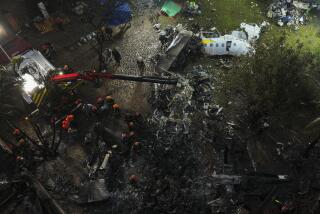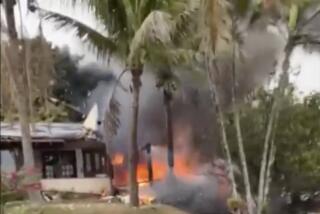Honduran 727 Hits Mountain; at Least 131 Die
TEGUCIGALPA, Honduras â A Honduran jet carrying 146 people slammed into a mountain south of this capital city Saturday, killing at least 131, including the Honduran labor minister, officials said.
Three Americans were known to be among the survivors, according to Raul Bonilla, general manager of TAN-SAHSA airlines. The exact number of Americans on the flight was not immediately clear.
The cause of the crash was not immediately known.
The plane, a Boeing 727-200, was on approach to Tegucigalpaâs Toncontin Airport when it reportedly began breaking apart and crashed into a 6,000-foot peak called Cerro Hules, about 25 miles south of the capital.
Ten hours after the 7:45 a.m. crash, rescue workers had recovered 125 bodies from the still-smoldering wreckage.
Maj. Alejandro Arguello, the Nicaraguan civil aeronautics chief, quoting early eyewitness reports, told reporters in Managua, âApparently part of the fuselage, the roof of the plane, tore off.â
Airline officials, however, said driving winds may have caused the accident and denied the plane had broken apart before it crashed.
Among the survivors was the planeâs pilot, Raul Argueta, who suffered serious bruises and burns, and two flight attendants.
Arguetaâs relatives quoted him as saying that he tried to land the plane on a small soccer field near the town of Las Mesitas. They did not say why he attempted an emergency landing.
Honduran officials, who called it the nationâs worst air disaster, said that one of the planeâs flight recorders had been located.
Flight 414, with a final destination of Houston, originated in San Jose, Costa Rica. It stopped in the Nicaraguan capital of Managua before heading for the Honduran capital.
A resident near the crash site said the plane was on fire before it hit the ground.
âI saw the plane coming down in flames . . . and then I heard a loud noise in the distance,â the witness, Pedro Martinez, told Radio HRN.
Other witnesses said the plane clipped a hill, slid about 300 yards and burst into flames.
Jorge Antonio Sierra, a farmer who witnessed the crash and rushed to the scene, said he found two survivors asking for help.
âA women, whose one leg was smashed, had died after she had moved away about four meters from the flames,â he said.
Survivor Rosario Ubeda said she remembered little about the crash.
âI heard strange noises and shouting. I remember nothing (after that),â she told reporters from her hospital bed in Tegucigalpa. Hospital officials said she had suffered fractures of the pelvis, both legs and an arm.
Another survivor said passengers had little warning.
âThe pilot announced that, in a few minutes, we would arrive in Tegucigalpa,â said Hernan Madrid, 40. âWe entered a cloud and the plane began to tremble and came down. Later, explosions were heard.â
âWhat weâre seeing here is tremendous . . . a really hellish scene,â said Rolando Sarmiento, a reporter for Radio HRN. âItâs a horrible scene. The bodies are all over the place. There are at least 15 bodies completely charred.â
Control tower employees at Toncontin Airport said unusually strong winds were blowing as the plane tried to land, confirming what airline officials had said.
According to an early passenger list provided by the airline, 11 Americans were on board the jet, which was carrying 138 passengers and eight crew members.
However, Mark Jacobs, a U.S. Embassy spokesman in Tegucigalpa, said as many as 20 Americans were aboard the aircraft.
In Washington, a State Department official identified one of the American survivors as Eugene Van Dyk, a management specialist for the U.S. Agency for International Development.
Van Dyk, whose U.S. hometown was not available, is based in Honduras and was returning from a business trip to Costa Rica.
Airline officials identified a second American survivor as Curtis Reed Shaffer and said an unidentified American woman was hospitalized after being pulled from the wreckage by rescue workers.
A partial passenger list, released by the airline, identified other Americans on board as Marie Apodaca, Edward Apodaca, A. Absevans, Lea Browning, Tony Friedrich, Robert Heyr, Connie Montealegre, Gregory Pagla and Daniel Yurista. It provided no ages or hometowns.
American officials in Washington identified Pagla as a Marine guard at the U.S. Embassy in Managua, but could not confirm that he was aboard the flight.
Airline and government officials said the dead included Honduran Labor Minister Armando Blanco Paniagua; Jose Ricardo Fasquell, chairman of Hondurasâ College of Forestry Engineers; Maria Ivon de Oqueli, the wife of a deputy health minister, and Fanny Sanchez, a daughter of Defense Minister Col. Wilfredo Sanchez.
Also killed was Mario Rodriguez Cubero, an official in the Costa Rican presidentâs office, that countryâs embassy here said.
Officials said most of the bodies recovered were badly burned, making identification difficult.
âThere was maybe five or 10 minutes before the plane caught fire, which gave some people the opportunity to get out,â said fire department spokesman Francisco Medina.
But many people were trapped in the wreckage by broken limbs, and burned in the ensuing inferno, he said.
The plane crashed in a remote area unconnected by telephone lines or main roads. Firefighters did not arrive at the scene until 40 minutes after the accident, Medina added.
Nicaraguan officials reported at least 65 Nicaraguans were on board, while Honduran Radio said seven U.N. officials and 32 Hondurans were also among the passengers.
A U.S. military spokesman in Tegucigalpa said the Honduran government notified American officials of the crash around 8:30 a.m. and asked for American assistance in rescuing possible survivors.
The spokesman, Bruce Jessup, told Cable News Network that four U.S. aircraft, including two medical helicopters, were provided. The United States has a large military contingent based in Honduras.
Officials of Boeing and the National Transportation Safety Board were expected to arrive today to begin investigating the crash.
In the last two years, there have been a number of incidents involving Boeing jets losing engines, wheels or parts of their fuselage. Most were blamed on metal fatigue, which can affect older jetliners.
The jet that crashed Saturday was 21 years old, according to Boeing.
BACKGROUND The Honduran airlines Boeing 727 that slammed into a 6,000-foot peak south of Tegucigalpa was a Model 200. This is a stretch version of the familiar three-engine craft. Up until 1986, the 727 had the second-best safety record. However, in the last few years, the aging fleet--the first ones were built in 1963--has been involved in several major crashes that were caused by structural or metal fatigue. In May of this year, the Federal Aviation Administration ordered $142 million in modifications to the older Boeing jets, including structural reinforcement and replacement of a variety of parts. The program was to have been put into effect this month.
More to Read
Sign up for Essential California
The most important California stories and recommendations in your inbox every morning.
You may occasionally receive promotional content from the Los Angeles Times.










